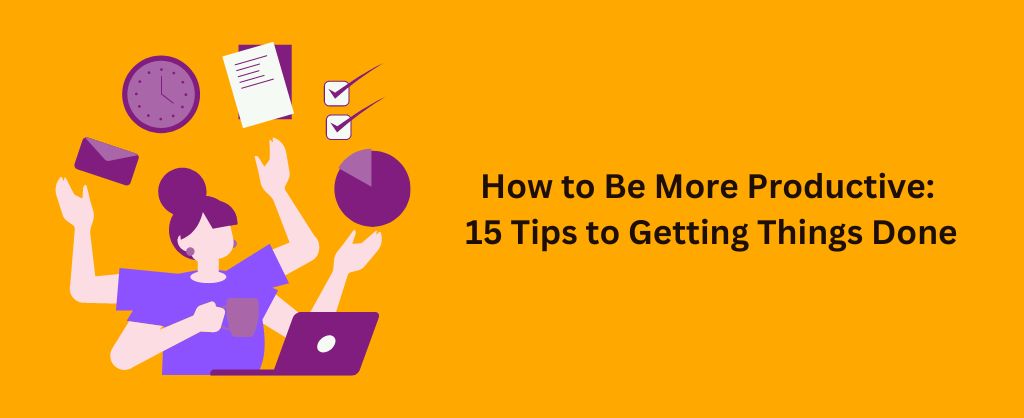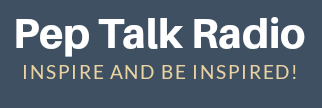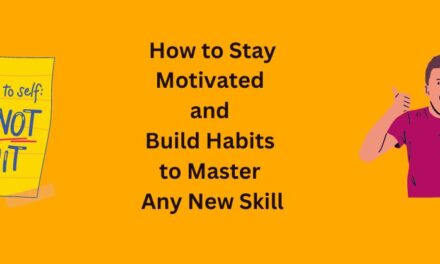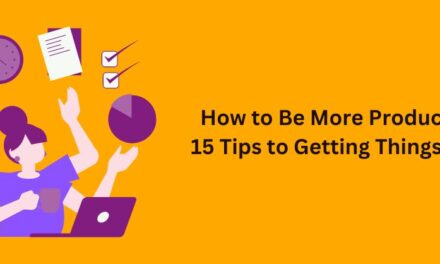15 Ways to Improve Productivity and Get Things Done Faster

We all want to be more productive and get more done each day. But with all the distractions and responsibilities we have, it can be tough to stay focused and efficient.
The good news is there are some simple productivity hacks you can try to help you stay on track and accomplish your goals.
Here are 15 tips to boost your productivity
1. Plan Your Day in Advance
One of the best ways to optimize your productivity is to plan out your day in advance. This allows you to map out how you’re going to spend your time and decide what tasks and projects should be your top priorities.
- Make a detailed to-do list or schedule the night before so you walk into your workday knowing exactly what needs to get done. Outline the specific steps you need to take to complete each task.
- Use a planner or digital calendar to map out blocks of time for your most important work. Schedule your priorities first before adding other meetings and tasks.
- Set reminders for deadlines and appointments so they don’t creep up on you. Knowing what’s upcoming helps avoid last minute scrambling.
- Build in some buffer time for unexpected tasks that come up or things taking longer than expected. Don’t overschedule your day.
Having an advance plan prevents you from wasting time each morning figuring out what to do. It also helps you stay focused and direct your energy toward productive work instead of getting sidetracked.
2. Leverage Productivity Tools
Take advantage of technology tools designed to streamline workflows and keep you organized. Certain apps can optimize the way you plan out tasks, collaborate with others, and actually get work done:
- Task management tools like Trello, Asana, Todoist, and Microsoft To Do allow you to create task lists, set due dates, assign work to others, track progress, and organize your projects into boards or lists.
- Calendar apps like Google Calendar, Outlook, and Calendly make it easy to schedule meetings, appointments, reminders and keep track of deadlines. Integrations with other apps give you a centralized place to manage it all.
- Note taking apps like Evernote, OneNote, and Bear provide a place to collect notes, lists, web clippings, files and more for quick reference. Sync across devices to access everywhere.
- File sharing apps like Dropbox, Google Drive and Box give you cloud storage to access files from anywhere and the ability to collaborate in real time.
Take some time to test out solutions to find the best productivity tools that suit your personal workflow and style. When leveraged effectively, they can help maximize efficiency and organization.
3. Minimize Distractions
Distractions lurk everywhere these days, from phone notifications to colleagues dropping by your desk. Multitasking often hurts more than it helps, so minimize distractions to focus:
- Set your devices to “Do Not Disturb” to mute notifications for blocks of time. Disable distracting sounds and pop-ups.
- Close out of email, social media, and apps not required for your current task so they aren’t begging for attention.
- Work in areas away from others when you need to concentrate deeply, such as a private office, empty meeting room, or library.
- Wear noise-canceling headphones and listen to relaxing or instrumental music to block out surrounding distractions.
- Use website blocker apps like Freedom or RescueTime to limit access to time-wasting sites when you need sustained focus.
- Politely decline invitations for casual meetings or conversations when you’re heads down on an important deadline.
Giving your full attention to one task at a time without distractions can help you achieve peak productivity and motivation.
4. Take Regular Breaks
While being constantly busy may seem productive on the surface, burning the midnight oil often backfires. Your brain actually needs regular breaks to recharge fully.
- Set a timer or reminder to take a 5-10 minute break every 45-60 minutes. Short, frequent breaks boost mental stamina over long breaks.
- Step away from your computer to disrupt the screen addiction pull. Stretch your legs, grab some water or a healthy snack, chat with a coworker, or just stare out a window.
- For longer breaks, take a quick walk outside if possible, or do some light exercise or yoga stretches. Breathe deeply for a few minutes to give your eyes a break.
- Do an unrelated leisure activity like reading, listening to a podcast, or playing a quick game. Let your mind relax into a different mental mode.
Giving your brain some breathing room helps you return to work feeling more focused, creative and energized. You’ll be more productive in the long run.
5. Tackle Important Tasks First
It takes a lot of mental energy to focus on top priorities and tough tasks. Get these done early when you feel most motivated:
- Look at your to-do list and identify the 1-3 most time-sensitive, important tasks to complete that day. Do these first before you have a chance to put them off.
- Set a timer for 60-90 minutes to work intently on the difficult task without getting distracted. Avoid context switching until you’ve made significant progress.
- For large projects, identify the next milestone or concrete chunk you can complete in one session before coming up for air.
Checking a big, challenging task off your plate first thing in the morning sets a sense of momentum for the rest of the day. You’ll feel productive and accomplished heading into the rest of your to-dos.
6. Batch Similar Tasks
Group related tasks together into blocks on your schedule to maximize focus:
- Schedule emails, calls, meetings, and administrative work during specific times rather than sprinkling them throughout your day.
- Devote chunks of time to knock out related tasks all at once, like doing all your follow-up emails back-to-back.
- Gather materials, prep information, and line up what you need to complete a certain type of task before diving in.
Consolidating similar duties makes you more time-efficient because there’s less mental gear switching required. You can get into a rhythm and flow from one task to the next seamlessly.
7. Delegate When Possible
Take things off your plate by delegating duties to others when feasible:
- Make a list of tasks that someone else could potentially help with, either a colleague, assistant, freelancer or virtual assistant. These might be recurring administrative duties or one-off projects.
- Clearly explain what you need done and provide ample instructions, guidelines, examples and resources to set them up for success. Check in periodically.
- Leverage tools like Trello, Asana or Monday.com to assign tasks to others, set due dates, track progress and collaborate. Provide training if needed.
- Don’t micromanage delegated tasks, but communicate standards for the end result. Trust your team and avoid re-doing work.
Delegating eliminates the need to context switch, freeing up mental space so you can tackle higher priorities and use your time more effectively.
8. Set Time Limits
Put time constraints around tasks to help yourself work efficiently:
- Use a timer, stopwatch or alarm to chunk bigger tasks into smaller blocks of focused time, like 25 or 50 minutes. The time pressure motivates you to buckle down.
- Limit meetings and calls to set lengths based on the agenda. Stick to the schedule to avoid dragging things out unnecessarily.
- Give yourself tight deadlines for completing assignments, even if they’re self-imposed. Harness a sense of urgency.
- Use website blockers to limit time on distracting websites to 5 or 10 minute bursts.
Applying time boundaries encourages you to make the most of every minute, preventing wasted time and lack of focus. You’ll get more done.
9. Cut Out Perfectionism
Striving for excellence is great, but don’t become a victim of perfectionism:
- Set a time limit for working on a task, and once time’s up, move on. Shifting to the “good enough” mindset is key.
- Focus on the 20% of effort that will get you 80% there, then ship it. Don’t obsess over minor details that won’t matter to the end user.
- Remind yourself done is better than perfect. Releasing work fuels progress, whereas over-editing causes stagnation.
- View mistakes and imperfections as learning opportunities rather than failures. Excessive self-criticism saps productivity.
Letting go of unattainable perfection frees up a ton of time and mental bandwidth. You can move onto the next task and apply lessons learned.
10. Take Intentional Breaks
Don’t just instinctively reach for your phone during breaks. Be intentional about how you recharge:
- Do a short guided meditation or breathing exercises to relieve stress and clear your mind. Calm or Headspace are great apps.
- Take a quick walk outside to get fresh air and a dose of nature. Exposure to sunlight also boosts energy.
- Drink some water to rehydrate. Dehydration can mimic fatigue. Opt for healthy snacks like fruits and nuts to refuel.
- Do some light stretches or foam rolling. Relieving muscle tension helps you focus.
- Listen to upbeat music or call a friend or family member. Social connection boosts your mood.
- Take a power nap. 10-20 minutes can restore alertness and cognitive performance.
- Read an uplifting book or article unrelated to work to give your brain a break.
Being deliberate about how you re-energize will leave you feeling refreshed and ready to tackle the next task with full focus.
11. Create Consistent Routines
Build routines around key parts of your workflow to boost productivity on auto-pilot:
- Start each morning the same way, like exercising, breakfast, reading, and responding to emails. Consistent morning routines eliminate decision fatigue.
- Have set places where you work on certain tasks, like always writing at the same desk or chair. Environmental cues get you in work mode.
- Schedule creative work or deep focusing tasks for when you have the most energy, like mornings if you’re a morning person.
- Review your calendar every Sunday night to prep for the upcoming week and get a head start.
Habitual routines around your essential responsibilities reduce the activation energy required each day. You conserve willpower and work efficiently without thinking.
12. Say No to Non-Essentials
Don’t spread yourself too thin saying yes to every request. Prioritize ruthlessly:
- Politely decline or delegate tasks that don’t align with your core priorities and goals. Protect your time.
- Limit impromptu meetings by suggesting scheduling a different time to discuss when you have availability.
- Pare down your to-do list by eliminating superfluous tasks that “should” get done but realistically won’t impact much.
- Unsubscribe from newsletters and communications that aren’t really necessary to free up mental bandwidth.
Being choosy about what you take on and letting go of non-essential tasks keeps your workload manageable. You can devote energy where it truly matters.
13. Take Time Off
Make sure to use your vacation days and unplug completely from work. Time spent relaxing and recharging sharpen your focus and creativity.
- Even if you can’t take extended vacations, schedule 3-day weekends every couple months or take Fridays off to create long weekends.
- On vacation, actually disconnect from work by turning on auto-reply, delegating urgent tasks, and silencing work-related notifications.
- Do relaxing activities like reading, hiking, cooking or spending time with family and friends. Avoid scheduling too many tasks.
- If you need a quick restore, take one unexpected personal day by calling in for a “mental health day”.
Extended time off gives you permission to fully recharge. You’ll return feeling inspired, clear-headed and ready to crush it.
14. Learn to Let Go
Don’t brood over small mistakes or imperfect work. Forgive yourself and move forward.
- When you catch yourself over-analyzing something that went wrong, intentionally shift your focus to the present moment.
- View failures as valuable feedback to implement next time rather than beat yourself up. Uber-critical inner dialogue drains energy.
- Remind yourself that no one expects perfection. Your worth isn’t defined by output. Progress, not perfection, is the goal.
- Spend just 5 minutes processing regrets or disappointments through journaling, then consciously let them go.
Releasing the need for perfection and not clinging to the past helps you maintain motivation and optimism. You get to start fresh each day.
15. Automate Where Possible
Look for ways to eliminate repetitive tasks through automation:
- Set up automatic payment reminders for recurring bills so you don’t have to manually pay each month.
- Use apps like IFTTT, Zapier or Automate to set up triggers that automatically complete rote tasks across platforms.
- Create templates for repetitive communications like sales emails, newsletters, or status reports.
- Use features like saved replies in email, Quick Parts in Word, or Text Expanders to auto-insert frequently used content.
- Invest in tools like chatbots or robotic process automation (RPA) to handle high-volume mundane tasks.
Automating repetitive manual work allows you to focus energy on high-value priorities requiring strategic thinking. Streamline what you can.
The bottom line is that boosting productivity is about working smarter, not harder. Try picking 2-3 of these hacks to implement over the next few weeks.
Experiment to find the techniques that work best for your workflow and personality.
Don’t forget to track your progress so you can continually refine your approach. With some targeted strategies, you’ll be getting more done in less time.










